Cabinet Upright | Initial release date 28 October 1994 Series Killer Instinct | |
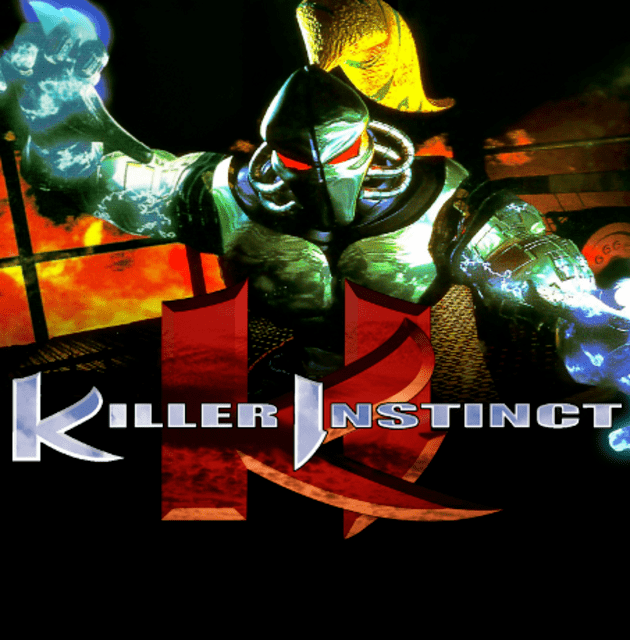 | ||
Publisher(s) MidwayRarewareNintendo Programmer(s) Mark BetteridgeChris TilstonMartin Hollis Artist(s) Kevin BaylissTim Stamper Composer(s) Robin BeanlandGraeme Norgate Mode(s) Up to 2 players simultaneously Similar Killer Instinct games, Rare games, Fighting games | ||
Killer Instinct is a fighting video game developed by Rare and published by Midway and Nintendo. It was released as an arcade game in the fall of 1994 and, the following year, ported to the Super Nintendo Entertainment System (SNES) and the Game Boy. The game's plot involves an all-powerful corporation organising a fighting tournament. The story was adapted in a limited comic book series published under the short-lived Acclaim Comics imprint.
Contents
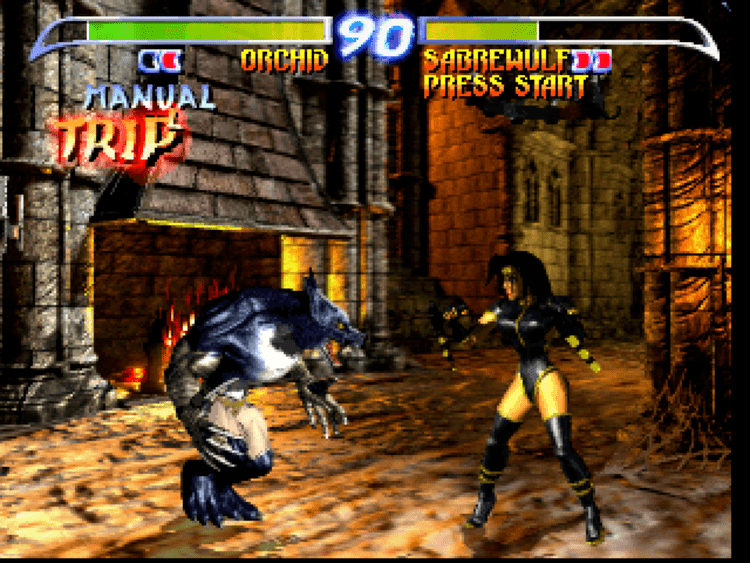
Killer Instinct features several gameplay elements unique to fighting games of the time. Instead of fighting enemies in best-of-three rounds bouts, each player has two life bars. The player that depletes the other player's life bars first wins the match. The game also introduced "auto-doubles", a feature which allows players to press a certain sequence of buttons to make characters automatically perform combos on opponents. Also featured in the game are "combo breakers", special defensive moves that can interrupt combos.
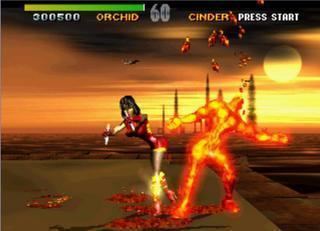
Critically acclaimed, Killer Instinct was followed by a sequel, the 1996 arcade game Killer Instinct 2, later ported to the Nintendo 64 as Killer Instinct Gold, as well as a 2013 revival of the franchise as a launch title for Xbox One. A port of the original game is included with the 2013 game under the title Killer Instinct Classic. Retrospective lists by various publications included it among the best fighting games of all time.
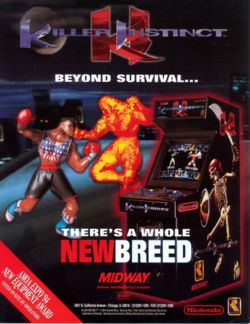
Gameplay
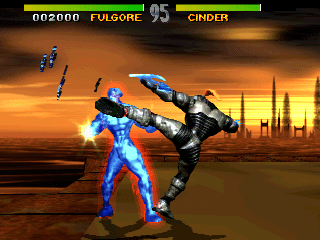
Killer Instinct plays like many other fighting games, in which the player controls a character to beat an opponent in a one-on-one encounter. The game borrows the attack set of Street Fighter and is also inspired by the finishing moves from Mortal Kombat. There are also several features that distinguish it from other franchises:

Plot
Ultratech is a very powerful megacorporation which organises a tournament called Killer Instinct. Along with regular participants, experimental creatures created by Ultratech also fight in the tournament so their strength can be tested. Ultratech also discovers a technology to make bridges between dimensions, and releases a two-headed, one-eyed, satyr monster called Eyedol from this dimensional prison.
Characters
According to GamePro in 2010, Killer Instinct is "remembered for its colorful cast of combatants. KI featured a velociraptor, a sword-wielding skeleton, a creature made out of ice, and a host of other memorable characters." In 2012, Topless Robot wrote that Killer Instinct "featured one of the most amazing and varied cast of characters ever to grace a fighting game, including the Native American Chief Thunder, the demonic skeleton Spinal, fiery criminal Cinder, the killer cyborg Fulgore and the vicious velociraptor-hybrid Riptor."
Development and release
In Spring 1994, Nintendo signed a licensing agreement with WMS Industries, Midway's parent company, which enabled Midway to develop and market arcade games using the "Project Reality" hardware (later to become the Nintendo 64) and formed a joint venture company called Williams/Nintendo to market Nintendo-exclusive home conversions of these games. Killer Instinct was announced as the first of these games. The announcement came at a time when Nintendo was still known for its stance against violent video games. To avert speculation that Killer Instinct would not be as violent as the title suggests, Nintendo's director of marketing George Harrison stated that "Williams would not have entered into this deal if they thought their hands would be tied. We won't restrict them in any way." He added that Nintendo felt that an industry-standard ratings system, which was expected to be in place by the time the home version was released, would make their stance against violent games no longer necessary.
Initially released to arcades in 1994, Killer Instinct did not actually run on Nintendo 64 hardware, but on proprietary arcade hardware co-developed by Rare and Midway, and created by Chris Stamper and Pete Cox. This hardware uses a 64-bit MIPS CPU and the Nintendo 64 file format for data structure, but not the Nintendo 64 memory media or graphics technology. Despite this, the game's attract mode advertised the game as planned to be "available for your home in 1995 only on Nintendo Ultra 64", "Ultra 64" being the name intended at that point for what ended up being the Nintendo 64. The game was slated to be part of the North American launch lineup for the system. However, the Nintendo 64's release was delayed and the game was ported to the Super Nintendo Entertainment System and the Game Boy instead.
Killer Instinct was the first arcade game to use an internal hard disk drive in addition to the game's ROMs. This allowed it to store massive amounts of data thereby giving it the ability to have more detailed graphics than other games of this genre. The game used pre-rendered sprites for characters, created with Silicon Graphics computers and the backgrounds were pre-rendered as a "movie" which simply adjusted frames based on the players' current location. Killer Instinct's R4600 processor was clocked at 100 MHz. Unlike most arcade games of the time, Killer Instinct did not display which version number of the game is being played.
In the SNES port many of the features the arcade version were altered, downgraded, or removed. The graphic detail was vastly reduced and the character sprites were smaller. The stages with a 3D panning camera were simplified into a 2D panning view using parallax scrolling for the background and mode 7 for the ground or arena, thus simulating a pseudo-3D effect. Zooming and scaling were removed. Some of the stages were redesigned. The full motion videos that showed the characters after a victory were replaced by still images. Voice samples and sound effects were severely limited, whether shortened or missing altogether, and the music's quality was noticeably lower. Most of the characters preserved their special moves and danger moves. However, some of the special graphical effects — notably the shadow move effect — were removed. To make up for the loss of overall quality, some other modes were added, such as a training mode, a tournament mode (used for multi-player purposes), among others. When released in Europe, Australia, Canada and the United States, the SNES game had black cartridge casing, instead of the standard grey shell. The TV advertisement for Canada and the United States showed a person cutting through the arcade cabinet with a chainsaw to reveal an SNES console with the game plugged in. Killer Cuts, an arranged soundtrack CD featuring original music from Killer Instinct was released as a pack-in for the SNES release of the game, included with the first 100,000 copies sold in the USA and the first 20,000 copies sold in Canada. The soundtrack was digitally re-released as part of a double-album set with the Killer Instinct: Season One soundtrack on October 14, 2014.
A Game Boy port was also made, but cuts were necessary due to the system's limitations. As a result, neither Cinder nor Riptor are featured and the moves were severely altered due to the more limited controls of the portable. The game supports some colouring when played in a Super Game Boy, which also allowed for a two player versus match to be played by inserting a second controller.
A digital port of the game's arcade version, titled Killer Instinct Classic, is available as part of the "Season One Ultra Edition" of Killer Instinct for the Xbox One. This port includes a number of additional features, such as a new training mode, unlockable character sprite galleries and cutscenes, several visual filters, and the ability to play the game in both its original 1.4 revision and its later 1.5D revision. An update in late December 2014 added online multiplayer functionality as well.
Reception
Killer Instinct was a commercial hit and gained some critical acclaim. An early 1995 article on the fighting games industry in Electronic Gaming Monthly stated that "For now, the undisputed king at the arcades is Killer Instinct". The SNES version of the game was also well received upon its release, selling 3.2 million units. VideoGames reviewer Tyrone Rodriguez gave the game a score of 8 (Great), stating his preference of it over Mortal Kombat 3 (the other editors' additional scores being 8–6–6). GamePro criticized that the SNES version suffers from a lower frame rate than the arcade version and is also missing some of its best sounds and graphical effects, and complained that the combo system makes it too easy for experienced players to defeat newcomers with a single chain of hits. However, they concluded that "This version of Killer isn't flawless, but it is surprisingly addictive and fun to play." The four reviewers of Electronic Gaming Monthly were divided, with Andrew Baran commenting that "while it's a nice attempt on the Super NES, it wasn't the same" as the arcade version, whereas the other three declared it "a superb translation" which has lower quality graphics and sound than the arcade version but retains its content, playability, and overall feel. They scored it a 7.75 out of 10. Computer and Video Games gave the game a review score of 93%, adding: "Rare weren't lying when they said the home version would play better than the coin-op: no-one realised they were talking about the SNES!"
The four reviewers of Electronic Gaming Monthly panned the Game Boy version, unanimously concluding it to be "an arcade translation that should never have been attempted on the Game Boy." They particularly complained of the difficulty in pulling off moves with only two buttons, the pixelated graphics, and the poor sound. They scored it a 2.5 out of 10. GamePro, in contrast, declared it to be second only to the Game Boy version of Street Fighter II among portable fighting games, arguing that the two-button control is "a little awkward but still masterable" and that the graphics are less than outstanding only when unfairly compared to the SNES version.
Retrospectively, Killer Instinct was ranked as the 148th best game made on any Nintendo system by Nintendo Power in 2006, as well as the 95th on a similar list by Official Nintendo Magazine in 2009. In platform-specific retro lists, it was also ranked as the 19th and 38th best SNES game of all time by ScrewAttack and GamesRadar respectively, and as the 13th best arcade game of the 1990s by Complex.
Killer Instinct was included on several lists of top fighting games of all time, including by ScrewAttack in 2008 (ranked fifth best), GamePro that same year (ranked 18th best), and UGO in 2010 (ranked tenth best). In 2004, GamesTM called it possibly "the best combo-heavy fighter ever;" ranking it as the eighth top fighting game of all time in 2009, Virgin Media stated that Killer Instinct was "most famous for having the longest combos in the business." Killer Instinct was voted the sixth top 2D fighting game of all time by Crave Online users in 2007, and ranked the sixth best 2D fighting game of all time by Complex in 2013.
Legacy
A sequel titled Killer Instinct 2 was released in 1996. Like the first game, it was ported to a home console, this time to the Nintendo 64 as Killer Instinct Gold.
A new Killer Instinct, published by Microsoft and developed by Double Helix Games and Iron Galaxy Studios with input from Rare, was released as a launch title for the Xbox One in 2013. Certain releases of the game include the Killer Instinct Classic port of the original arcade game and its sequel.
